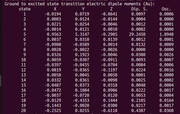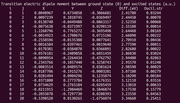Multiwfn forum
Multiwfn official website: //www.umsyar.com/multiwfn. Multiwfn forum in Chinese: http://bbs.keinsci.com/wfn
You are not logged in.
- Topics:Active|Unanswered
Pages:1
#1Multiwfn and wavefunction analysis»Transition density matrix»2024-06-03 07:06:06
- cy21d042
- Replies: 1
-
Dear Prof Tian Lu,
I am trying to generate the TDM plot for an acceptor molecule. There are various options to symmetrise or non-symmetrize and whether to take the square or the square root. How do I know which option to select for a better visualization of the plot?
Thank you in advance.
#2Re:Multiwfn and wavefunction analysis»Fragment PDOS plot»2024-05-21 04:41:26
I am using the following Gaussian input file for the DOS calculations.
%nprocshared=8
%mem=4GB
%chk=Y6.chk
# b3lyp/6-31++g(d,p) iop(3/33=1,3/36=-1) pop=full scrf=(solvent=chloroform,pcm) empiricaldispersion=gd3bj
.....
Is it correct?
Thank you in advance.
#3Multiwfn and wavefunction analysis»Charge transfer state»2024-04-05 06:24:47
- cy21d042
- Replies: 1
-
Can I use Multiwfn to find the intramolecular charge transfer (ICT) state using a Gaussian TDDFT result of 40 excited states? What is the parameter that I should look for to differentiate between the local excited state and the ICT state?
Thank you in advance.
#4Multiwfn and wavefunction analysis»Fragment PDOS plot»2023-04-28 06:30:57
- cy21d042
- Replies: 3
-
I am trying to generate a PDOS plot for a molecule of different donor-acceptor units. Which output fch file shall I use for this fragment PDOS ( energy or optimization)? I am using Gaussian to generate the output files.
Thanking you in advance.
#5Re:Multiwfn and wavefunction analysis»Transition Dipole moment of Excited state»2022-11-27 05:27:12
Thank you very much for your response.
#6Re:Multiwfn and wavefunction analysis»Transition Dipole moment of Excited state»2022-11-25 13:11:18
I tried the gaussian TDDFT calculation using the keyword IOp(9/40=4). Still, there is a difference in the print values obtained for the transition dipole moment of any excited state from gaussian and multiwfn. I am also attaching the screenshot of the values obtained for a particular excited state from gaussian and multiwfn.
Thanks in advance.
#7Re:Multiwfn and wavefunction analysis»Transition Dipole moment of Excited state»2022-11-22 04:20:02
Thankyou for letting me know.
#9Multiwfn and wavefunction analysis»Transition Dipole moment of Excited state»2022-11-21 14:25:36
- cy21d042
- Replies: 6
-
How do we know the transition dipole moment of a particular excited state? Also, why are there differences between the dipole moment values obtained from Gaussian TD-DFT calculations and Multiwfn?
Pages:1


